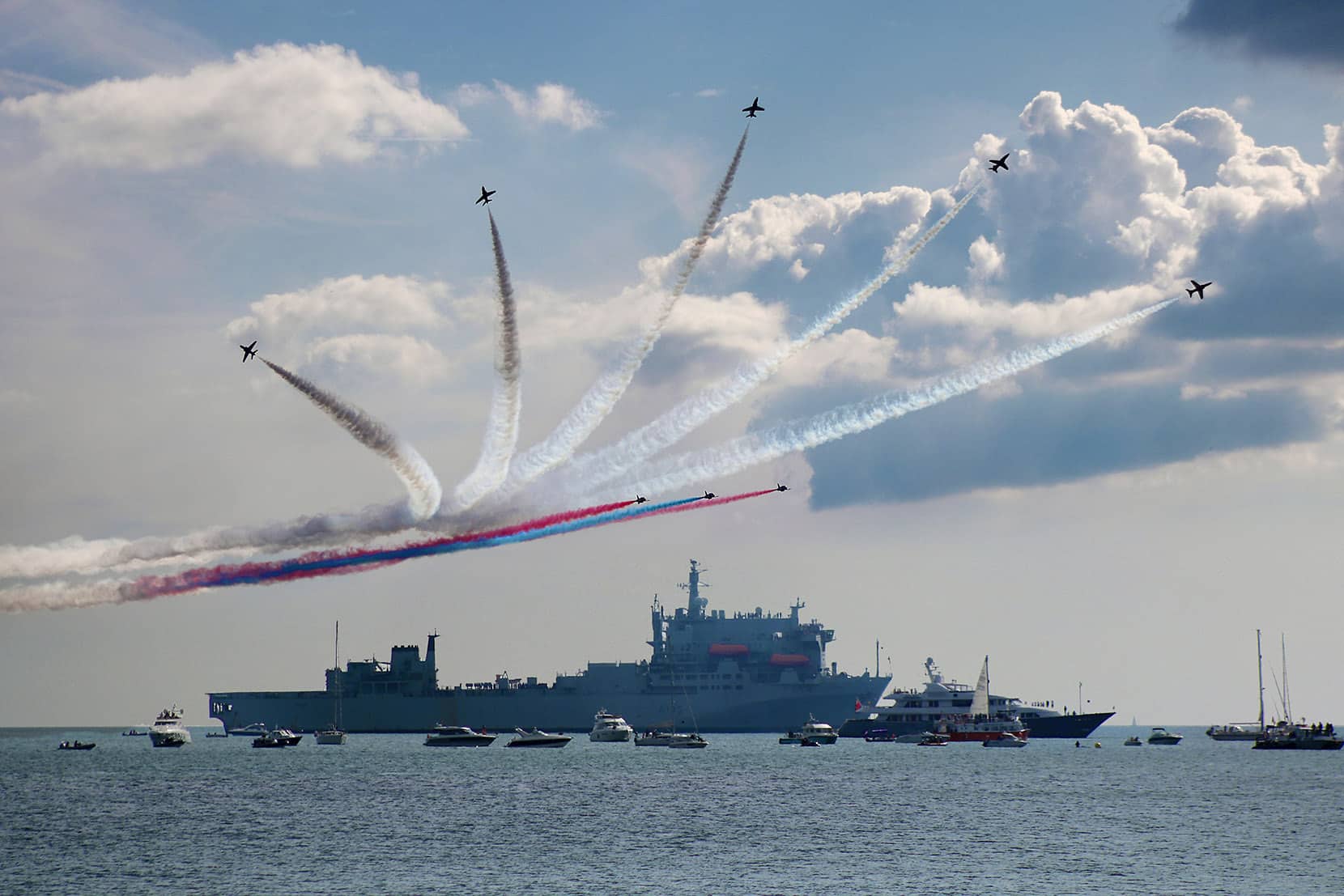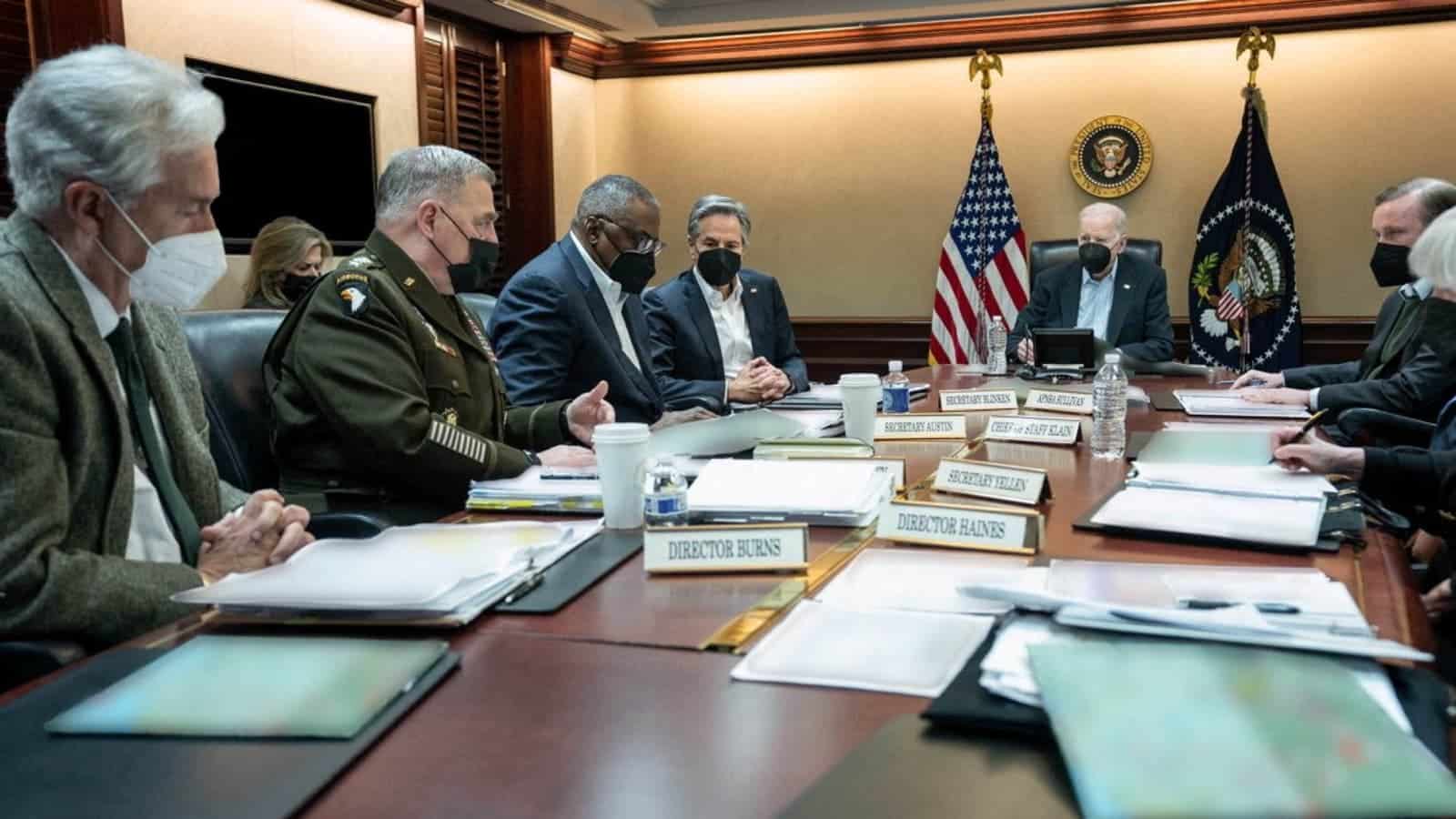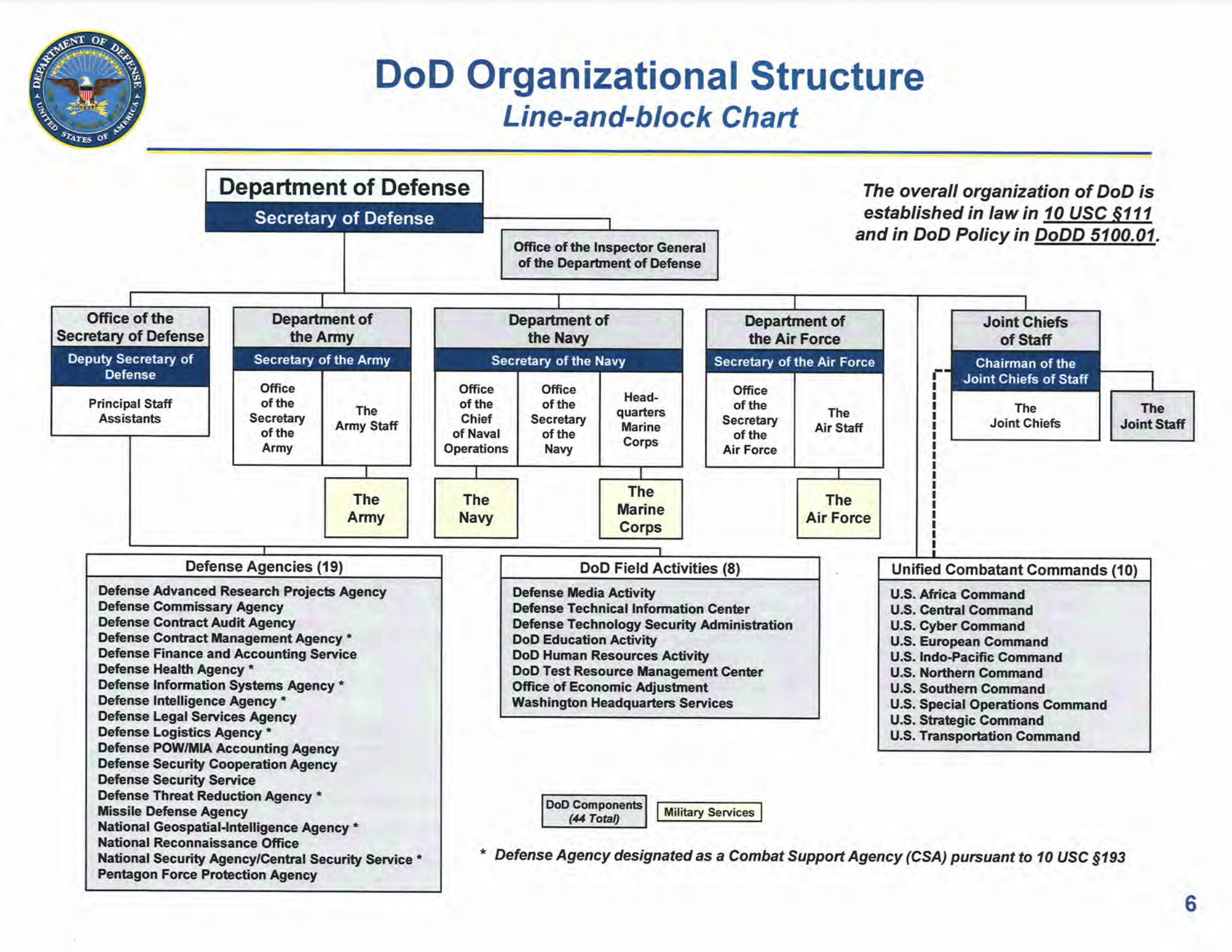
The National Defense
3000 words • 10 minutes

Rarely a day goes by in which we do not hear about the United States military. There is always talk about budgets, overseas wars, arguments about the size of U.S. forces, and even whether there is even a need for a full-time military.
No worries, however, as in this brief article I won’t debate the wisdom of past wars such as Vietnam, Gulf War II, or the withdrawal from Afghanistan. Nor will I discuss the details of the 858-billion-dollar defense budget. For your sake, dear reader, I’ll also skip the discussions surrounding the concepts of a “just war” and/or a “preventative war.” Instead, my goal is to give you a basic idea as how the Department of Defense (DoD) and the military give options to the President and senior leaders. In other words, how the United States organizes it defense and makes grand strategies work.
—Let’s begin with three thoughts:
- You may not be interested in war but war is interested in you—Leon Trotsky.
- If the Army loses, the nation perishes—General Douglas MacArthur.
- The Pentagon said today…
Part 1 – The National Security Strategy, National Defense Strategy, and the National Military Strategy
Since the beginning of time, if there is an area, or “domain” as it is called in the current military parlance, in which one group or nation can take war to another, then it most certainly will be exploited. The historic domains of land, sea, and air are now joined by those of bio-warfare, cyber-warfare, and space-warfare. The United States, along with its allies, makes clear to potential foes that it will employ warfighting strategies and tactics across all these domains (with perhaps the exception of bio-warfare) to defend its citizenry, its economy, its democratic freedoms, and the fabric and cohesion of its society—indeed a broad remit!
Since, and perhaps even before, WW2, we can think of our national defense as a long wave that runs through our national decision making. By this, I mean that the defense structure and its priorities remain surprisingly consistent from year to year and even from administration to administration. While certainly not completely immune from the political tides, the national priorities usually enjoy deep and wide support across the body politic.
As an example, think of Teddy Roosevelt launching the Great White Fleet (so called because of the color of the paint used on the ships) to show the world that the U.S. was now a two-ocean power. Every president since, whether Republican or Democrat, has hewn to this course. In fact, it is no longer even a matter of debate as presidents from Carter to Reagan to Bush to Obama to Trump to Biden have all endorsed this aspect of U.S. national power.
But in broader terms, how does the United States define national power and what thinking gives rhyme or reason to it? To answer that question, we must first look at three crucial documents: The National Security Strategy (NSS), the National Defense Strategy, and the National Military Strategy (NMS). The NSS and NDS are published every four years while the NMS appears every two.
The NSS, which can be found at the Whitehouse website and only takes about 30 minutes to read, clearly spells out the national interests. What are those? Well, they are the structures that build and maintain free and prosperous nations: Individual and collective freedoms, basic democratic values, economic stability through trade, the importance of allies, the rule of law, and the resolve to parry current and future threats.
While at first glance a reader might find the language rather broad—after all, what does a “call for freedom” have to do with tanks and missiles and Marines? In fact, the NSS provides three critical functions for our nation’s defense.
The first is that it serves as a common starting point around which all the governmental and defense agencies can align their efforts. The NSS gets everyone, no pun intended, in line and marching toward the same goals. The importance of this unity cannot be overestimated as unity of purpose is crucial to any large-scale organizational effort.
Second, and almost as equally important, is that it gives a clear description to both our friends and our foes of what the U.S considers important interests, what it considers inimical to those interests, and how robustly it will defend them. While the term “red line” does not, and most likely never will, appear in any of these documents, the NSS describes what the U.S considers its vital organs.
Third, the NSS makes clear to the reader that national defense does not rest solely on the shoulders of the military. Instead, that responsibility is borne collectively across our society, economy, and government.
The NSS is grounded in the bedrock principle that national power is based on four major elements—elements that are easy to remember under the DIME paradigm: Diplomatic, Industrial/Information/Intelligence, Military, and Economic while some modern defense strategists advocate for the MIDFIELD acronym: Military, Informational, Diplomatic, Financial, Intelligence, Economic, Law, and Development. As you can imagine, an effective exercise of national power combines all of these elements and the NSS takes time to discuss each of them to align, and then guide, all the stakeholders.
Now before I talk about the NMS and NDS, let me describe the structure of the U.S military and the DoD.
The Structure of the Department of Defense and the Military
It is the Constitution, of course, that gives Congress the authority to declare war. Further, in Article 1 Section 8, it grants that august and inestimable body the additional authority to raise and support an army and navy as well as to call forth the militia to perform various tasks as they might arise.
Fast forward from the late 1700s to 1947 when President Truman signed the National Defense Act (NDA) which converted the Department of War into the DoD and created the Departments of the Air Force and the Central Intelligence Agency (CIA). The NDA also stood up the National Security Council (NSC) with its position of a National Security Advisor (NSA) in order to organize and prioritize the flow of military and diplomatic intelligence to the President.
Then, in 1986, the Goldwater-Nichols DoD Reorganization Act further streamlined the DoD chain of command and strengthened the civilian control of the military.
Naturally the POTUS, although a civilian, is the Commander in Chief (CINC). The next link in the chain of command is the Secretary of Defense (SECDEF) who, in addition to carrying out the orders of the CINC, is entrusted in managing the agencies and military forces under him.
In turn, one can think of the SECDEF, and his/her Deputy, as having direct control over four important activities and groupings.
The Services
I like to think of the first grouping under the SECDEF as the military departments. Known simply as “the services,” these are the Air Force, Army, and Navy. The Marine Corps slots in with the Navy and the Space Force with the Air Force. To further affirm civilian oversight and control, the military departments are also headed by a civilian—thus the titles Secretary of the Air Force, the Secretary of the Navy, and the Secretary of the Army. Only then, after three levels of civilian control, do we find a uniformed service member in the person of the Chief of Staff of the Air Force, the Chief of Staff of the Army, and the Chief of Naval Operations.
The Service Secretaries and the respective Chiefs are given the responsibility to organize, train, and equip. The civilian leadership decides what kind of defense forces it wishes to have and the Service Secretaries and Chiefs then recruit and train those forces to fulfill the mission. It is important to note that the Secretaries and Chiefs themselves do not have war-fighting responsibilities per se, but rather to provide the war-fighters the trained soldiers, sailors, Marines, and airmen. This of course then raises the question who then are the war-fighters? Well…here is where is gets interesting.
The Combatant Commands
The second grouping over which the SECDEF has direct control are the combatant and functional commands. At the moment there are seven combatant commands and four functional ones for a total of eleven. Each of these is headed by an officer of four-star rank and are composed of fighting forces from all the services. These are known as joint forces and in them one can find Navy, Air Force, Army, and Marines depending on what warfighting expertise is needed. The combatant commanders are the ones who actually prosecute the war-fighting mission. They are the ones you hear mentioned in those dispatches that usually start with the bland verbiage of “The Pentagon said today that U.S. forces struck at targets deep in country X or Y.”
The combatant commands cover specific regions around the world and it is here that we find such organizations as the Central Command (Central Asia), Africa Command, and the Indo-Pacific command. The functional ones, for example the Transportation Command (think of moving the men and materiel) and the Strategic Command (think nuclear missiles) have a worldwide responsibility and are not limited to any one specific geographical region.
Office of the Secretary of Defense (OSD)
The third grouping is the Office of the Secretary of Defense (OSD) itself. Within the OSD we find a robust list of defense agencies and activities such as the Defense Intelligence Agency (DIA), The National Security Administration (NSA), the Geospatial offices, Auditing (don’t laugh), Logistics, and many others. Most, but certainly not all, of the OSD and agency personnel are civilian—which is in contrast to the military departments and combatant commands. The OSD also prepares the National Defense Strategy which slots into the NSS. An easy way to remember this is that the National Military Strategy plugs into the National Defense Strategy which in turn plugs into the National Security Strategy.
The Joint Chiefs of Staff
The fourth grouping, the JCS is headed by the highest-ranking officer in the military and is somewhat erroneously mistaken by the public for being the officer commanding all warfighting activities. Yet, as we saw, warfighting authority flows from the POTUS to the SECDEF and then directly to the combatant commanders. What then do the Joint Chiefs do?
Well, first there are eight of them in total. Six of them wear, figuratively, two hats. These six are the Chiefs of their respective services (Army, AF, etc.) but also, part of the JCS. In their role as a Service Chief, they are tasked with the organizing, training, and equipping the forces. In their role on the JCS however, they have two completely different responsibilities. The first is to craft defense policy and the second is to provide advice to the SECDEF and POTUS. They are the officers who look over the horizon to spot potential threats to the nation and to give the POTUS and other senior leaders the tools and options to deal with those threats.
The National Security Council, the National Security Advisor, and the National Director of Intelligence.
Although not under SECDEF or military purview, it is worth mentioning the role of these direct advisors to the president. The NDI receives, processes, and interprets information from the 18 intelligence agencies and presents it to the President in a coherent manner. The National Security Adviser chairs the NSC (except when the POTUS is present) and is the principal advisor to the President on all national security matters—whether they be diplomatic, military, cyber, or even economic. The NSA distills and prioritizes information for the President. You often hear of the daily intelligence and security briefings the president receives and these are the individuals who prepare it.
As a note, under the Trump administration the Chairman of the Joint Chiefs is now a voting member of the National Security Council. Naturally he has a very large staff to handle this responsibility.

National Security Counsel
Meeting about the Ukraine war
Disinformation and propaganda are, in our modern electronically interconnected world, an extremely serious and growing problem. Apart perhaps from a hegemonic China or a Russia intent on using a nuclear weapon, disinformation and propaganda are direct and immediate threats to the U.S.
Future challenges for both the military and our citizenry
Disinformation and propaganda are, in our modern electronically interconnected world, an extremely serious and growing problem. Apart perhaps from a hegemonic China or a Russia intent on using a nuclear weapon, disinformation and propaganda are direct and immediate threats to the U.S.
Nearly every day we see disinformation campaigns being played out against our senior military and civilian leadership. While the protests, for example, against the war in Vietnam were vocal and widespread, they had a single purpose—an end to the conflict in Southeast Asia. Today, expert disinformation efforts by our foes aim to sow seeds of chaos that attack the very credibility of our senior military and political leaders, defense policies, and even the functioning of the U.S. economy. Overall, the intent is to make national security a thoroughly political topic instead of one based on needed capabilities.
While robust Congressional oversight of the military and defense structures is absolutely mission critical, we need to be careful not to let the ebb and flow of political rancor effect our preparedness. Gulf Wars I and II are one thing in that they were, with all due respect, relatively easy. A major multi-domain attack from China, however, is another matter altogether and significantly more threatening.
Our citizens need to listen carefully to what the DoD and military services are really saying and not what a partisan pundit might opine. There is no need to become a defense policy expert, but having a general idea helps the nation.
As an example, during the Obama administration the DoD and Navy made known to the SECDEF and POTUS concerns about climate change. Almost immediately the TV talking heads were thrashing about as if they were a fish out of water. Accusations were leveled that the military had bought into a global warming scam.
Well…even the most cursory look at the topic revealed that the military did not stress whether the change was due to man-made warming or not. Nor were they in thrall to moving the country back to pre-industrial age levels of power consumption.
Instead, with 40% (2.8 billion people) of the world’s population living within 60 miles (100 Km) of a shoreline and the arctic areas now opening to global shipping, it is a subject that the Navy needs to closely watch. Add into the mix that Russia and other nations are casting a beady eye on the mineral deposits under the arctic regions, and the DoD and Navy would be grossly negligent if they were not keeping track of this.
A second example if I may. Before the Russian invasion of Ukraine there were consistent and ever more shrill attacks from the likes of TV pundit Tucker Carlson as to how our military forces have grown weak, emasculated, effete, and totally ineffective in comparison to the true warrior spirit of Vladimir Putin’s sinewy and masculine Russian troops who, according to this narrative, were steeled and steady fighters. As we have witnessed over the past year, we can see how that myth unraveled but not before the SECDEF Lloyd Austin and the Chairman of JCS General Milley were brought before Congress to provide some answers as to the supposed parlous condition and readiness of our troops.
As it turns out, General Milley indeed had answers. It is true he conceded that the services are struggling to meet recruitment goals. This seems to be a cyclical problem and he is tasked to find answer to the shortfalls. But the U.S. military is still an incredible nimble, robust, and lethal force. As we have seen in Ukraine, it is American equipment and know-how that the Ukrainians ask for.
The last example would be the disinformation campaigns claiming that our senior leaders are pushing a woke ideology at the cost of capabilities. General Miley vigorously pushed back against this.
With some units in the military now nearly 40% non-Caucasian the top commander has to be cognizant of his force structure. Our soldiers must be trained in everything from musketry to nuclear weapons and General Miley, like any competent manager and leader, realizes that he has to understand and motivate the soldiers, sailors, and airmen, who are tasked to defend us. If the Army fails, the nation perishes as per Douglas MacArthur, Knowing and understanding that young men and women of color might not be keen to worship General Lee or Stonewall Jackson is a first step to being an effective leader of soldiers instead of merely a manager.
As an aside, there is a very good recommendation being floated that the Army posts should be renamed for Medal of Honor recipients. Just as the Navy christens ships in the name of past heroes, the Army could honor their greatest no matter what their race, color, or creed while sidestepping, no pun intended, the minefield of the Civil War.
Again, my point is that important topics need to be understood by the public and not overshadowed by the latest political points being made by the chattering classes. The military has indeed made many errors, some grievous, over the years but it is up to all of us as citizens to make sure that we learn from those mistakes. After all, our existence depends on it.
I close with the admonition that as voters we have the power of the ballot box and thus civilian control of our national defense establishment. If we have concerns, we can ask questions of our representatives and demand answers—I have done so from the late Senator Arlen Specter’s office and was impressed at the detailed answers I received. With China now as a peer competitor and with both Russia and China showing hegemonic inclinations, we need to make sure that we are keenly aware of the United States elements of power and its defense. With future warfare sure to be fought across multiple domains, we must remember that whether we wish to be or not, we are all in this together!
![]()
A note or two
- It is worth mentioning that the NMS discusses why the U.S. does not adhere to a “no first strike” nuclear doctrine. This is just one of the reasons why friends and foes alike read these documents with keen interest.
- Soft power is another important element of national power and is something left to another discussion
A big thanks to Colonel Phil Jones for his assistance with this article. He has been an excellent mentor over the years in all things Geo-Political and Geo-Strategic.








Admittedly I never served in the Armed Forces. However, I do have some power of observation of the military and what it has become. When rainbow flags, DEI and feelings become more important than combat training, we have caused self-inflicted weakening. Mark Milly and Lloyd Austin are like the Hekawi Indians on the TV show F Troop: Afghanistan withdrawal, great execution by our troops; balloons passing over military installations, nothing to see here; extended navel cruises and inadequate maintenance of our navel vessels, no big deal. There are now more generals per enlisted personnel than ever before, so we have over management and under delivered good results.
As an overview of political influence, write out a timeline, without consideration of the commander in chief, and see the military capability/response. ’79 Iran Hostage crisis, Grenada, Dessert Storm, Mogadishu, 9-11, spread of ISIS, and withdrawal from Afghanistan. As they say, the record speaks for itself.
Nice untangling of the wiring diagram of how it all fits together at the DoD. You are right that most people do not know the real role of the Chairman JCS.
I share your concern about misinformation. We use it but are not aware in the slightest when it is used against us.